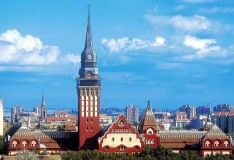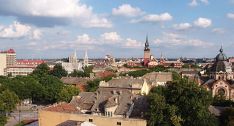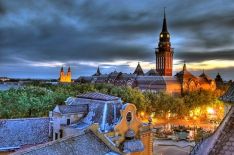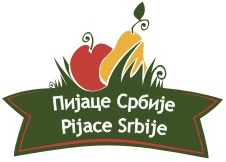The city of Subotica is located at the northern part of the Republic of Serbia, along the border to Hungary at 46 05’ 55’’ North Latitude and 19 39’ 47’’East Longitude. Its average altitude is 114m - 40m above the level of river Tisza, near Kanjiža; at 32m above the level of Danube, near Baja. The international freeway E 75 passes alongside Subotica. Kelebija border crossing is 10km away, while Horgoš border crossing is 30km away from the city. The land north from the city is a fertile sandy terrain with vineyards and orchards, while on the south there is arable land.
At present, the city and its surrounding municipalities have about 150.000 inhabitants: Hungarians, Croats, Bunjevac, Serbs and other nationalities. There are 18 major settlements around the city: Bajmok, Bački Vinogradi, Bačko Dušanovo, Bikovo, Višnjevac, Gornji Tavankut, Donji Tavankut, Đurđin, Kelebija, Ljutovo, Mala Bosna, Mišićevo, Novi Žednik, Palić, Stari Žednik, Hajdukovo, Čantavir and Šupljak. The city is linked to Palić, the old summer resort and lake.
The City Hall of Subotica is its largest and, according to many, its most beautiful building. It was built within two years, from 1908 till 1910. However, it took two more years to decorate its interiors. The building was designed by Marcell Komor (1868-1944) and Dezső Jakab (1864-1932), two architects from Budapest in the fashionable and modern style of the times: Hungarian art nouveau. Most of the decorations are dominated by stylized flower patterns. The City Hall is a harmonious blend of arts and crafts. With an overall height of 76m and the observation deck terrace at 45,5m with 105,08m in length and 55,56m of width, it covers a surface of 5838m².
The first mentioning of Subotica in written documents dates from May 7th 1391; however the settlement has surely been older. It has been established that people inhabited these territories even 3000 years ago. The fate of Subotica was clearly defined by its position between Europe and Asia, whilst, historically, it was between two opposing forces – the Austro-Hungarian and Ottoman Empires. Frequent migrations resulted in a diverse population on this military borderland, such as: Serbs, Hungarians , Germans, Slovaks, Jews, Bunjevci and Greeks… Both the rulers and the names of the city changed quite often. Since its first name: Zabatka given in 1391, the city has changed more than 200 names, however the most peculiar ones are Szent – Maria, Maria-Theresiopolis, Maria Theresienstadt, Szabadka and Subotica.






_234x204.jpg)
_234x204.jpg)
_234x204.jpg)
_234x204.jpg)
_234x204.jpg)
_234x204.jpg)
_234x204.jpg)

_234x204.jpg)
_234x204.jpg)
_234x204.jpg)
_234x204.jpg)
_234x204.jpg)
_234x204.jpg)
_234x204.jpg)
_234x204.jpg)


